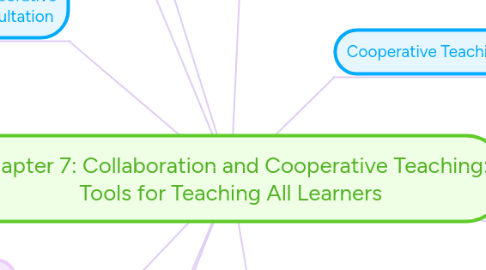
1. Collaboration: Two or more people working towards a common goal
2. Collaboration is useful when:
2.1. There is a need for multiple viewpoints
2.1.1. Knowledge of behavior of student at school vs at home that requires teachers and parents to collaborate
2.1.2. Cultures intersect
2.1.2.1. Collaboration is necessary to help a student who is enmeshed in both the culture of immigrant family and the dominant culture present at school
2.2. When there are tasks that must be delegated or divided into hierarchical processes
2.2.1. A paraeducator may carry out procedures planned by the teacher (Teacher focuses on planning instruction, para focuses on implementation)
2.3. Task is too overwhelming to do alone
2.4. A task requires a wide range of competencies
2.5. Accountability is key
2.5.1. "heightened sense of shared responsibility for all students" (Gargiulo and Metcalf 2013)
2.5.1.1. This is especially important for special ed students since they are frequently ignored or excluded in general ed settings
2.5.1.1.1. Collaboration enables inclusion
3. Benefits of collaborative consultation
3.1. Shared accountability—more likely that student's needs will be met because everyone that works with that child will keep each other accountable
3.2. Draw upon unique insights to better accommodate individual learners
3.3. Combine expertise
3.4. Enables school districts to serve all children
4. Multidisciplinary teams
4.1. A unified plan is created between all professionals involved
4.2. Evaluations are done independently
4.3. Specific services are provided seperately from one another
5. Draw on expertise of professionals from many different fields
6. Interdisciplinary teams
6.1. The only way team members are connected to each other is that they all have a shared goal
6.2. Typically there is no single outcome; there are instead many outcomes oriented towards the same goal
6.3. Each member of the team does their job completely independently of each other
7. Other benefits of collaboration
7.1. Increases access for students with special needs to a wider range of services
7.1.1. Allows teachers to find LRE easily because there is a dialogue between general education and special education professionals
7.2. Expands instructional opportunities
7.3. More effectively respond to varied needs of students by drawing on a wide range of expertise
7.4. Lowers student-teacher ratio (Gargiulo and Metcalf 2013)
7.4.1. Lower noise and visual distractions
7.5. Continual development: teachers learn from each other
7.6. "Models appropriate academic, social and help-seeking behaviors" (Gargiulo and Metcalf 2013)
8. Transdisciplinary teams
8.1. Boundaries between disciplines are less distinct
8.2. Professionals teach their skills to other team members
8.3. Team is collectively responsible for all services; responsibility is not divided strictly by professional background
8.4. Parents are full participants in the team
8.5. Initial testing is done in isolation
9. Cooperative Teaching
9.1. Teachers are equal
9.1.1. Team teaching
9.1.1.1. Teachers take turns presenting information
9.2. Teachers take on hierarchical roles
9.2.1. One teach, one support
9.2.1.1. Should not be used often because students may become overly dependent on the extra support
9.2.1.1.1. Scaffolding should be the goal
9.2.1.2. Assistant teacher is not necessarily always the special education teacher
9.2.1.3. One teacher acts in the role of assistant
9.2.2. One teach, one observe
9.2.2.1. Minimal planning as a team
9.2.2.2. One teacher instructs while the other collects data
9.3. Teaching requiring a divided classroom
9.3.1. Station teaching
9.3.1.1. Lesson is split up into parts, each teacher is designated a part
9.3.2. Alternative teaching
9.3.2.1. One teacher instructs students of a wide variety of skill sets, other teachers small group
9.3.3. Parallel teaching
9.3.3.1. Lesson planned together but is delivered to separate groups of students evenly split between teachers
